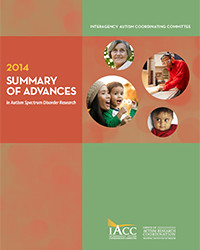Summary of Advances
In Autism Spectrum Disorder Research
2014
Caregiver-mediated intervention for low-resourced preschoolers with autism: an RCT
Kasari C, Lawton K, Shih W, Barker TV, Landa R, Lord C, Orlich F, King B, Wetherby A, Senturk D. Pediatrics. 2014 Jul;134(1):e72-9. [PMID: 24958585]
Families at the lower end of the socioeconomic scale with children with ASD are not often recruited to participate in ASD research, including research on early interventions for children with ASD. Over the past 10 years, ASD Early Intervention (EI) researchers have come to understand a great deal more about how such interventions can have real and positive effects on children with ASD, including by improving key behaviors, language, and social communication skills. However, proof of how well EIs could work for low resource families and their children has been lacking. To address this gap, the study authors recruited and screened a large number (112) of underserved families and their preschool-aged children with ASD to participate in a comparative study of two 3-month long, low-intensity EIs involving caregivers rather than professionals as the interventionists. The goal of the study was to determine if such short-term interventions handled primarily by the caregivers would improve key behaviors in the children. To begin, each participating family was randomly assigned to either the Caregiver Mediated Module (CMM) group, which facilitated the participation of children and caregivers in two 1-hour sessions per week at home together, or the Caregiver Education Module (CEM) group, which involved small group-based caregiver training for 2 hours each week in a neighborhood location without the child present. The two groups shared similar educational materials focused on teaching communication, the basics of behavior management, and developing routines. At the end of the study, study authors found that the children with caregivers in both groups improved in joint engagement (with their caregivers) and initiating joint attention (a child pointing to share something, for example). However, improvement in both behaviors was significantly greater among the children whose caregivers had worked with them in the home (CMM). At the 3-month follow-up assessment, the researchers found that the children who had received either intervention had maintained their improved skills in initiating joint attention compared to when they entered the program. For the CMM group the authors assessed changes in the children’s play behavior. While there was improvement in symbolic play (e.g., child has a doll feed a dog), there was no change in functional play skills (e.g., stacking blocks). The study was one of the first of its type to enroll a large racially and ethnically diverse sample of low resource families. As such, it is valuable for having supplied some of the first data on the success of interventions involving these families and for having indicated that caregiver-mediated interventions can help mitigate some of the most challenging symptoms of ASD in these children.
Parent-implemented social intervention for toddlers with autism: an RCT
Wetherby AM, Guthrie W, Woods J, Schatschneider C, Holland RD, Morgan L, Lord C. Pediatrics. 2014 Dec;134(6):1084-93. [PMID: 25367544][PMID: 25367544]
Effective early intervention (EI) for children with ASD could improve outcomes, particularly if the intervention begins “early,” meaning not too long after a stable diagnosis of ASD (possible at 18–24 months). Some studies testing interventions with preschoolers have shown significant improvements in joint engagement (two-way communication with care-givers), IQ score, and language skills. Other studies testing interventions with children near 24 months but younger than preschool age have also shown promise, primarily by improving parents’ early intervention skills, which are key to fostering long-term improvements in their children. With these past studies in mind, the current study authors decided to create an Early Social Interaction (ESI) Project to facilitate the involvement of parents, reduce the need for more intensive interventions later in life, and enable interventions to be more easily accepted and implemented at the community level. The purpose of this study was to test the comparative effects on toddlers with ASD of two 9-month parent-implemented interventions. The study consisted of 82 toddlers with a diagnosis of ASD and the children and their parents were randomly assigned to one of two groups. The first was called individual-ESI and the second was called group-ESI. The individual-ESI had parents meet with professional interventionists individually for three sessions per week (two at home and one at the clinic) for 6 months, then engage in two sessions per week (one at home and one in a community setting) for 3 months. Sessions included practicing supports and strategies, problem solving, and planning. The group-ESI included four or five families that met for one session per week. These sessions were usually held in playgroups at a clinic where parents could talk with the professional interventionists and other parents and practice using strategies to support their children’s social communication skills.
The study findings at the end of the 9-month period indicated that toddlers in the individual-ESI showed significant improvement in social communication at a rate much faster than the group-ESI. Children in the individual-ESI showed improvement in the areas of social affect (social demeanor and/or behavior, how one comes across to others) and expressive language (skills in expressing one’s wants and needs); however, the group-ESI saw no change in these areas. Also, the individual-ESI showed parent self-efficacy had positive gains in early social skills, including social communication, verbal skills, and daily living activities, whereas parents in the group-ESI saw worsening or no change in these skills. The study’s findings support individual-ESI over group-ESI for effectiveness in terms of child social skills and behaviors, and by using a parent-implemented model it can hopefully reduce the use of professionals and be more successful on a community level.




